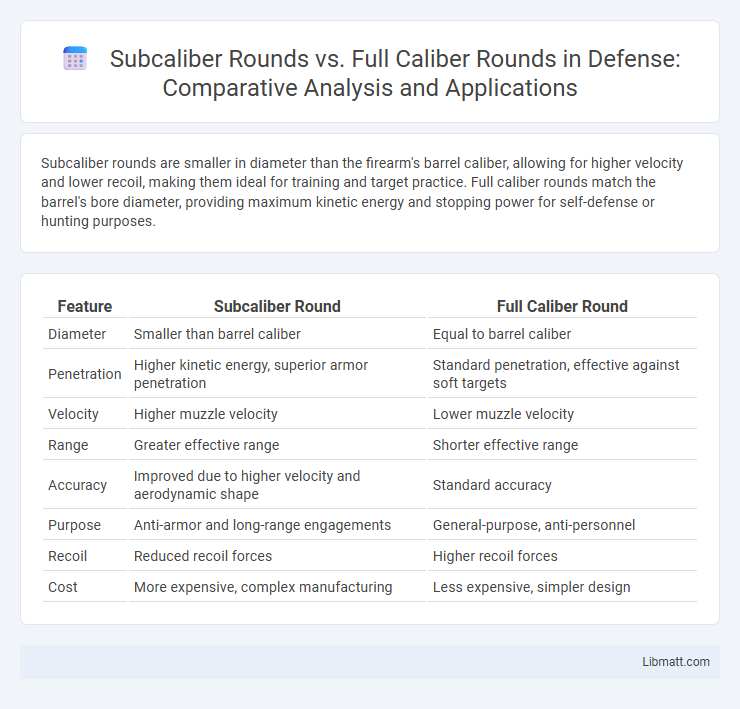Subcaliber rounds are smaller in diameter than the firearm's barrel caliber, allowing for higher velocity and lower recoil, making them ideal for training and target practice. Full caliber rounds match the barrel's bore diameter, providing maximum kinetic energy and stopping power for self-defense or hunting purposes.
Table of Comparison
| Feature | Subcaliber Round | Full Caliber Round |
|---|---|---|
| Diameter | Smaller than barrel caliber | Equal to barrel caliber |
| Penetration | Higher kinetic energy, superior armor penetration | Standard penetration, effective against soft targets |
| Velocity | Higher muzzle velocity | Lower muzzle velocity |
| Range | Greater effective range | Shorter effective range |
| Accuracy | Improved due to higher velocity and aerodynamic shape | Standard accuracy |
| Purpose | Anti-armor and long-range engagements | General-purpose, anti-personnel |
| Recoil | Reduced recoil forces | Higher recoil forces |
| Cost | More expensive, complex manufacturing | Less expensive, simpler design |
Introduction to Subcaliber and Full Caliber Rounds
Subcaliber rounds are smaller projectiles designed to be fired from a larger caliber barrel, improving velocity and penetration while reducing recoil. Full caliber rounds match the bore diameter of the firearm, offering greater mass and impact energy but often lower velocity compared to subcaliber rounds. Your choice between subcaliber and full caliber rounds depends on the specific application, such as target shooting, hunting, or tactical scenarios.
Definition and Core Characteristics
A subcaliber round features a projectile smaller in diameter than the barrel bore, often encased in a sabot to maintain barrel fit during firing, enhancing velocity and penetration. In contrast, a full caliber round matches the barrel's internal diameter, typically offering greater mass and stability with lower muzzle velocity. Subcaliber rounds prioritize armor-piercing performance and increased kinetic energy, while full caliber rounds emphasize impact force and projectile integrity.
Historical Development and Adoption
Subcaliber rounds, first developed during World War II, aimed to improve penetration capabilities by employing smaller projectiles with higher velocity, contrasting the traditional full caliber rounds which maintained consistent size and weight for balance and reliability. The German Panzerfaust and the American sabot rounds demonstrated early adoption of subcaliber technology, influencing modern armor-piercing ammunition and tank gun advancements. Full caliber rounds continue to dominate standard infantry and artillery use due to their versatility and established manufacturing infrastructure.
Design Differences: Construction and Materials
Subcaliber rounds utilize a smaller-diameter projectile encased in a sabot made from lightweight materials such as plastic or aluminum, allowing higher velocity and improved accuracy. Full caliber rounds consist of a single, full-diameter projectile constructed from dense metals like lead or tungsten, emphasizing penetration and stopping power. The sabot in subcaliber rounds separates upon exiting the barrel, optimizing ballistic performance without increasing barrel wear compared to full caliber designs.
Ballistics Performance Comparison
Subcaliber rounds exhibit higher muzzle velocities and flatter trajectories compared to full caliber rounds due to reduced projectile mass and increased propellant efficiency. Their smaller diameter decreases air resistance, enhancing range and penetration capabilities against armored targets. However, full caliber rounds typically deliver greater kinetic energy on impact, resulting in superior stopping power at close to medium ranges.
Armor Penetration Capabilities
Subcaliber rounds, such as APDS (Armor-Piercing Discarding Sabot) and APFSDS (Armor-Piercing Fin-Stabilized Discarding Sabot), achieve superior armor penetration by concentrating kinetic energy on a smaller, denser penetrator, often made of tungsten or depleted uranium. Full caliber rounds, including traditional AP (Armor-Piercing) shells, rely on mass and velocity but generally deliver less penetration against modern composite or reactive armor. The higher sectional density and velocity of subcaliber projectiles enable them to defeat thicker and more advanced armor systems compared to full caliber rounds.
Applications in Modern Warfare
Subcaliber rounds, featuring a smaller projectile diameter than the firearm's bore, are highly effective in modern warfare for enhancing armor penetration and increasing projectile velocity, making them ideal for anti-armor and precision targeting applications. Full caliber rounds, with their larger projectile size, provide increased stopping power and damage potential, suited for general infantry combat and effective suppression. Your choice between subcaliber and full caliber rounds depends on the mission requirements, balancing penetration capability against overall firepower and tactical flexibility.
Cost, Logistics, and Manufacturing Considerations
Subcaliber rounds offer cost savings due to reduced material usage and lower propellant requirements, making them cheaper to produce compared to full caliber rounds. Logistics benefit from their lighter weight and smaller size, allowing more ammunition to be transported and stored efficiently. Manufacturing of subcaliber rounds involves precise engineering for sabot components, potentially increasing complexity, but streamlined processes can offset these challenges for large-scale production.
Advantages and Disadvantages of Each Type
Subcaliber rounds offer higher velocity and improved armor penetration due to their smaller, denser projectiles, but they may suffer from reduced stability and increased barrel wear compared to full caliber rounds. Full caliber rounds provide better stability and are generally more effective for delivering explosive payloads, yet they often have lower velocity and penetration capabilities. Each type balances trade-offs between accuracy, penetration power, and barrel longevity depending on the specific combat application.
Future Trends in Ammunition Technology
Subcaliber rounds, designed with smaller projectiles and sabots, offer enhanced velocity and improved penetration compared to traditional full caliber rounds, driving future ammunition designs toward greater efficiency and armor-piercing capabilities. Advances in materials science enable the development of lightweight, high-strength projectiles that optimize kinetic energy transfer while minimizing barrel wear. Emerging technologies, including smart guidance and adaptive ballistics, integrate with subcaliber rounds to improve accuracy and effectiveness across diverse combat scenarios.
subcaliber round vs full caliber round Infographic

 libmatt.com
libmatt.com